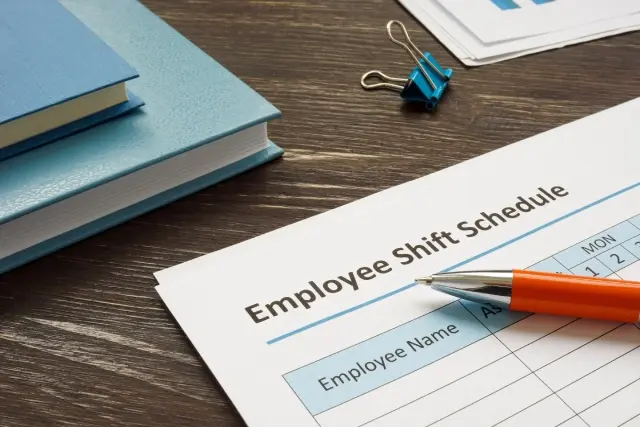Employee retention in the fast-food industry has always been a challenge. Many blame the high turnover rates on low wages or a lack of advancement opportunities. But the number one reason hourly workers quit is workload, a finding revealed in a survey of over 900 hourly workers conducted by Kathy Gosser, Ph.D. , University of Louisville professor of franchise management with 35+ years of experience working for KFC. (Check out our conversation with her here).
Whether you’re a restaurant manager or a franchise owner, there are several things you can do now to reduce turnover rates, streamline operations, and improve service at your business. And with only 54% of QSR employees reaching the 90-day mark at a job before quitting, the sooner you can solve your workload problems, the better.
The culprit behind overworked employees
Scheduling challenges
Anyone who has ever managed hourly employees knows that scheduling conflicts come with the territory. In addition to an industry-wide labor shortage, the inability to keep restaurants properly staffed is often a combination of schedule conflicts and poor planning.
Sometimes, the problem is booking an employee for a shift on a day that they’re unavailable or already requested to take off. Other times, scheduling challenges arise because workers suddenly become sick, encounter transportation problems, or experience family emergencies.
Some employers purposely assign fewer people to a shift than needed simply as a cost-cutting measure. It’s a short-term approach that can adversely affect a restaurant’s long-term retention prospects—as it can frustrate your staff by forcing them to pick up the slack.
A proven and effective way to overcome (or circumvent) these workload management issues is using an automated scheduler. Powered by AI, these tools optimize your existing staff rosters by removing guesswork and human error while respecting the work-life balance of your workers. A good automated scheduler can even track time or handle time-off requests for your employees.
No-show employees
Sometimes people don't show up for work. And in the worst cases, they don't give you any heads up. This leaves your restaurant unexpectedly short staffed, creating stress and additional work for those that are there. And on top of that, your employees are still human and can only do so much. Wait times will probably be longer. Your customers probably won't be all that happy.
As a manager, you're now on damage control. How do you find someone to cover the shift at the last minute? How do you reprimand someone for a no show? What do you say so the rest of your staff knows this type of behavior is unacceptable? And how do you give them the pep talk they need to preform under pressure?
When it comes to dealing with no-show employees, it's important to figure out why they're not showing up and not giving warning. Is it due to burnout? Or apathy? Or have you made it too hard for employees to request off? Maybe your employees need extra flexibility or input into how their schedules are assigned. Help your hourly workforce by providing more options about when they work and opportunities to share their preferred shift times. Exercising good workload management is key.
By mastering the art of scheduling, you can help your restaurant better rebound from the occasional no-show. In turn, it can also help you build a greater sense of trust and camaraderie among your team members since they'll know their coworkers won't leave them hanging. All of which results in better work environments, happier employees, and greater retention rates.
The importance of employee engagement
Engaged employees feel supported, valued, and appreciated at work. They tend to enjoy better relationships with their coworkers and managers and build stronger connections with their work. It’s this added sense of purpose and belonging that often results in greater employee retention.
Creating a positive work culture—by recognizing and rewarding employee achievements or providing opportunities for growth and development—is a great way to encourage engagement, motivate your workforce, increase efficiency, and lower costs.
According to a recent study, companies that make employee recognition a priority have workers who are 56% less likely to be looking for a new job. It can be as simple as consistent praise and gratitude or a more formal system to give employees awards or gift cards to show appreciation.
Increased employee engagement in the workplace can also be inspired by work relationships.
Gallup data suggests that simply having a best friend at work is strongly linked to increases in retention—along with improvements in profitability, safety, and inventory control. An employee with a best friend at work is also more likely to interact with customers and do more in less time.
Tips for improving employee retention
Here’s a few more actionable ways to address your QSR’s workload-related issues, including strategies for scheduling your employees, creating a positive work environment and fostering engagement:
- Evaluate individual workloads: Use your knowledge of your staff’s capabilities to ensure each shift has enough hourly workers with the right skills to effectively allocate job tasks.
- Cross train your workforce: By expanding their skill sets, you can ensure that employees aren’t underutilized, improve overall workload distribution, and even increase job satisfaction.
- Ask for employee feedback: Have regular discussions with your workers to gain insights into workload struggles, feelings of burnout, and other issues so you can address them.
Whenever possible, acknowledge employees who find opportunities to increase efficiency and tackle tasks more effectively. Recognition isn’t just motivation, but sets an example for the team.
Create a work culture where everyone gets a break
Prioritizing workload management is a critical element of any restaurant manager’s employee retention strategy. It starts with becoming more effective and strategic with how you schedule your hourly workforce and handle issues like no shows.
Ultimately, it’s about making hourly workers feel engaged and valued for what they do each day to make your restaurant successful. By building a positive culture and giving your employees a voice, you can improve retention and gain a reputation as a great place to work in the process.





